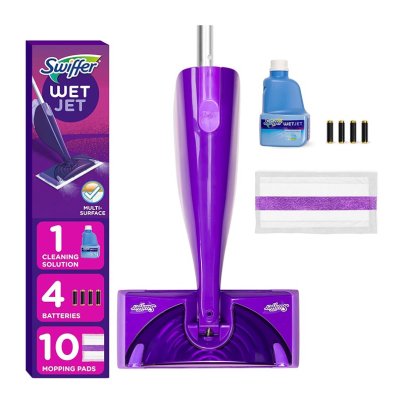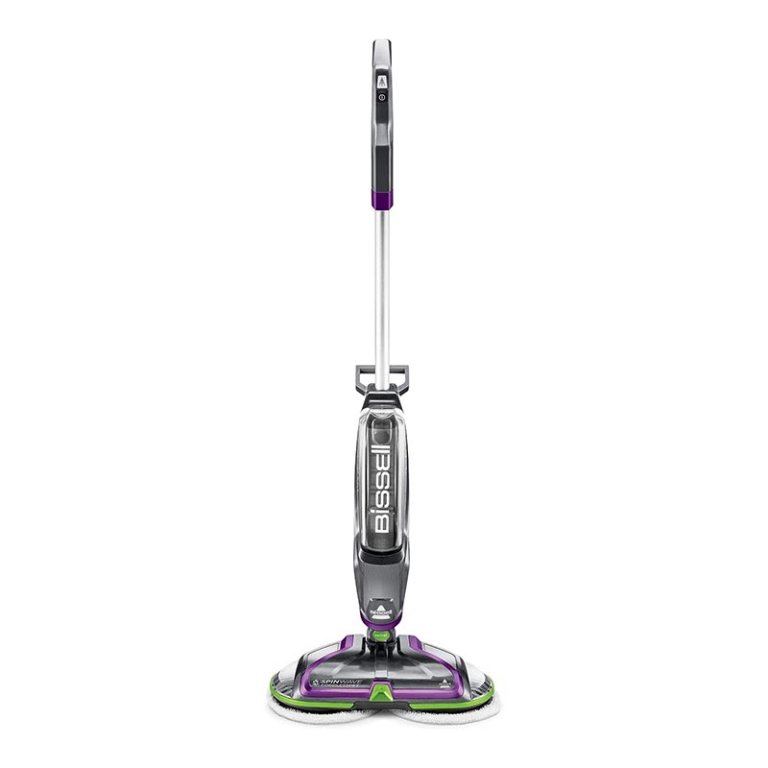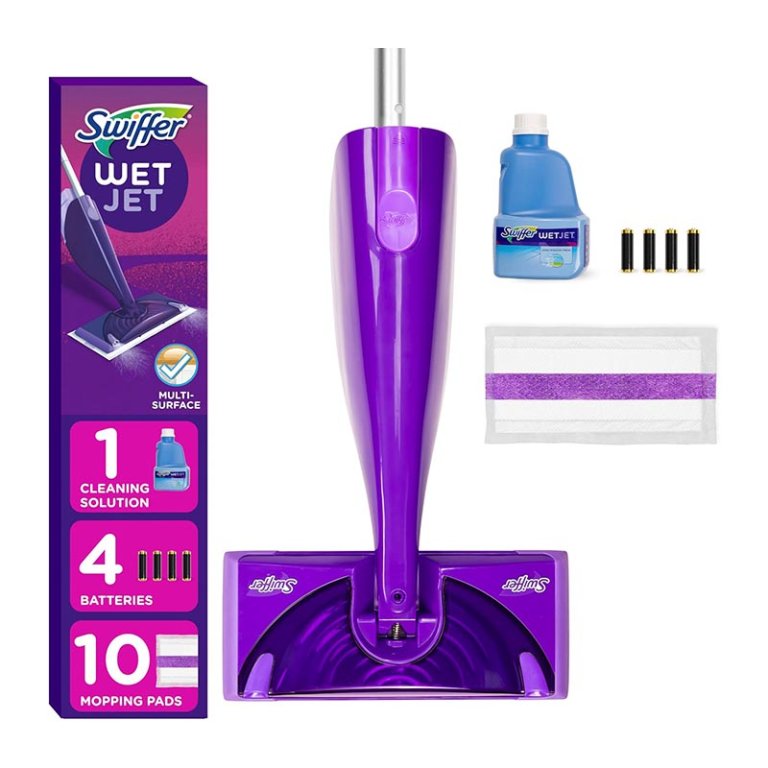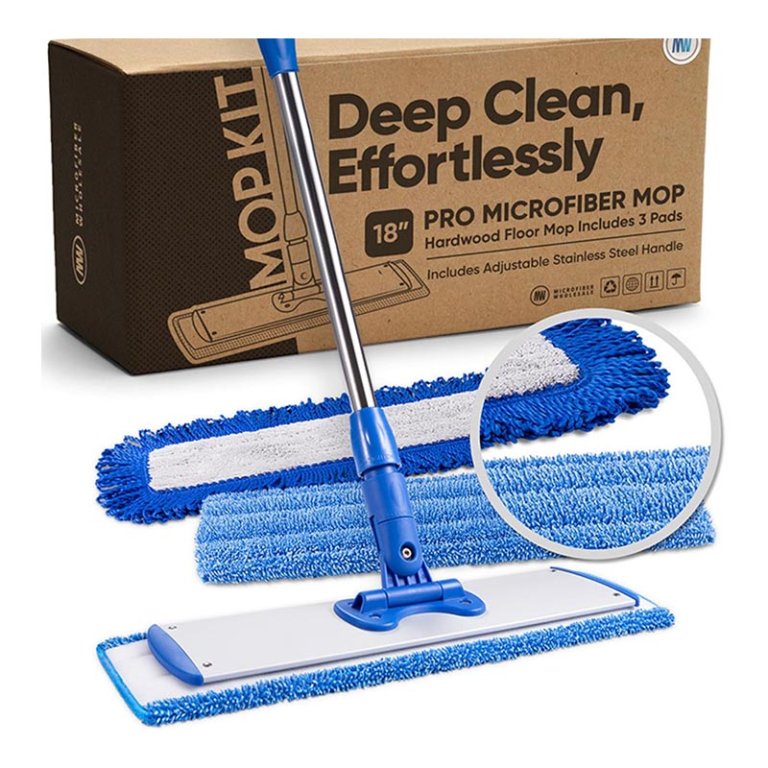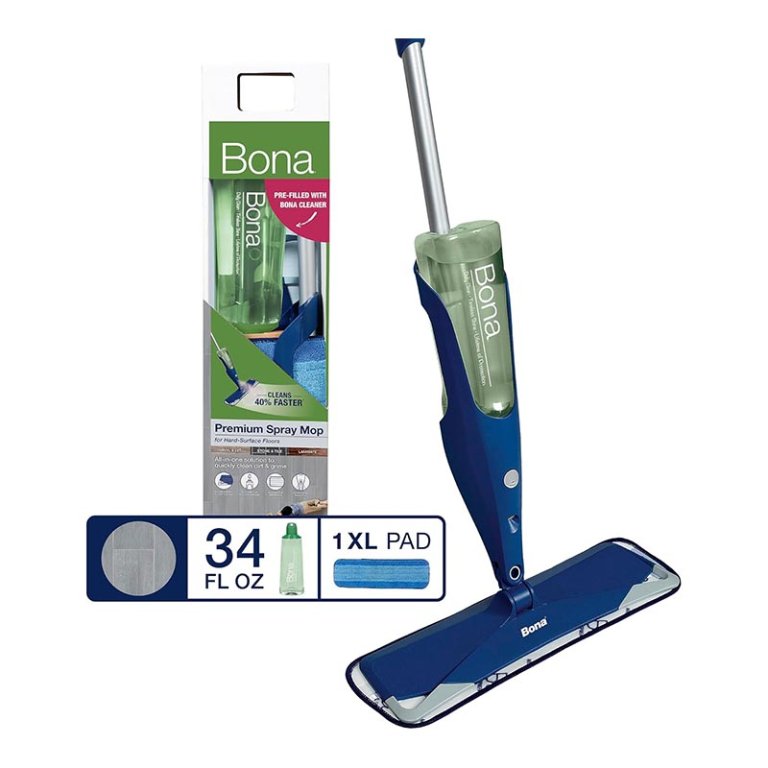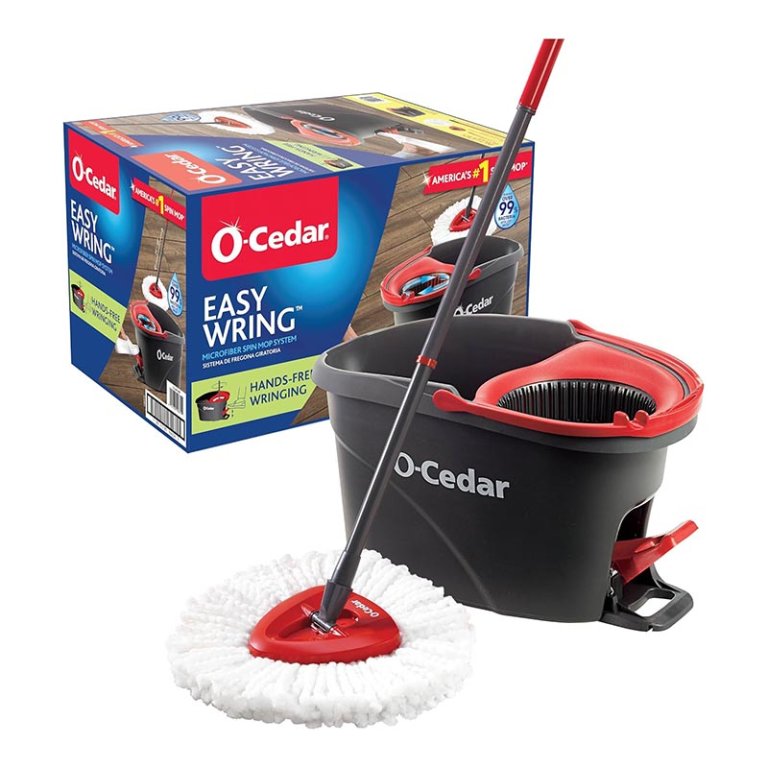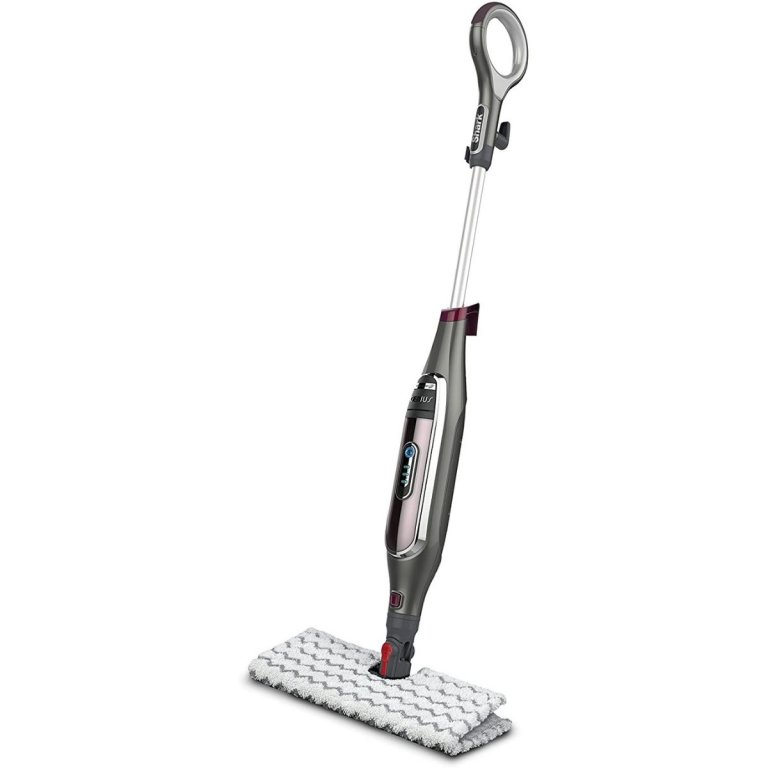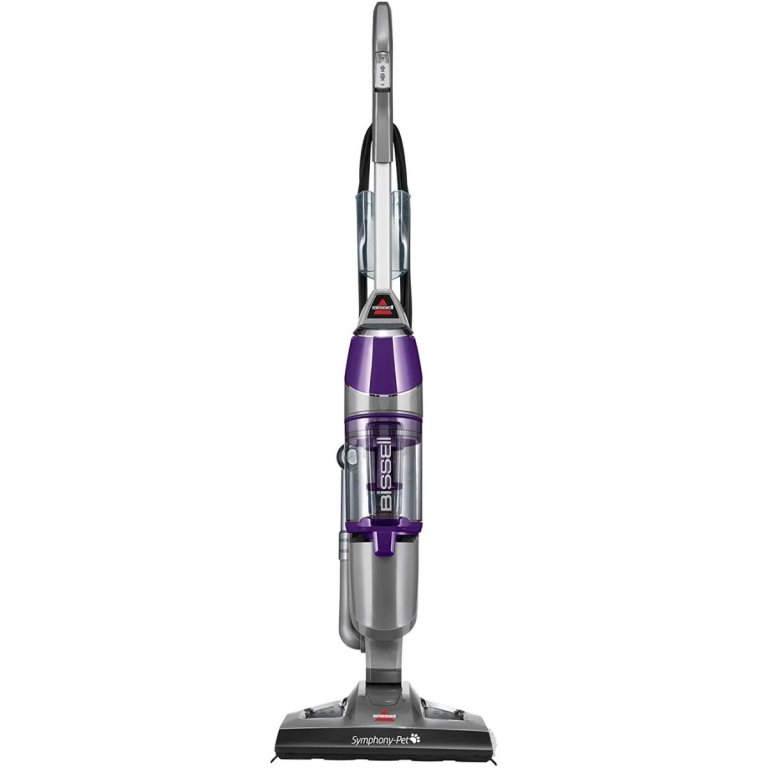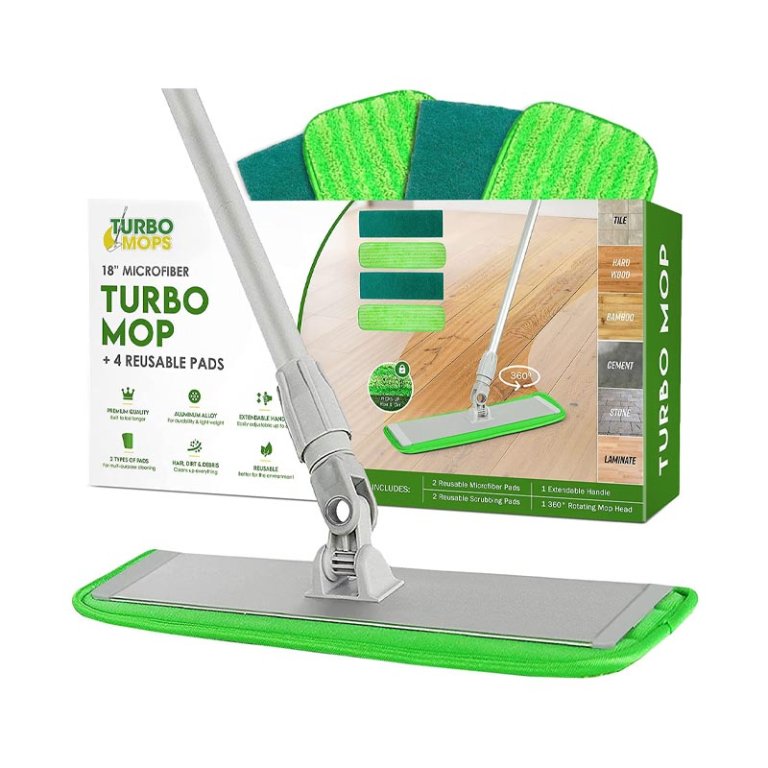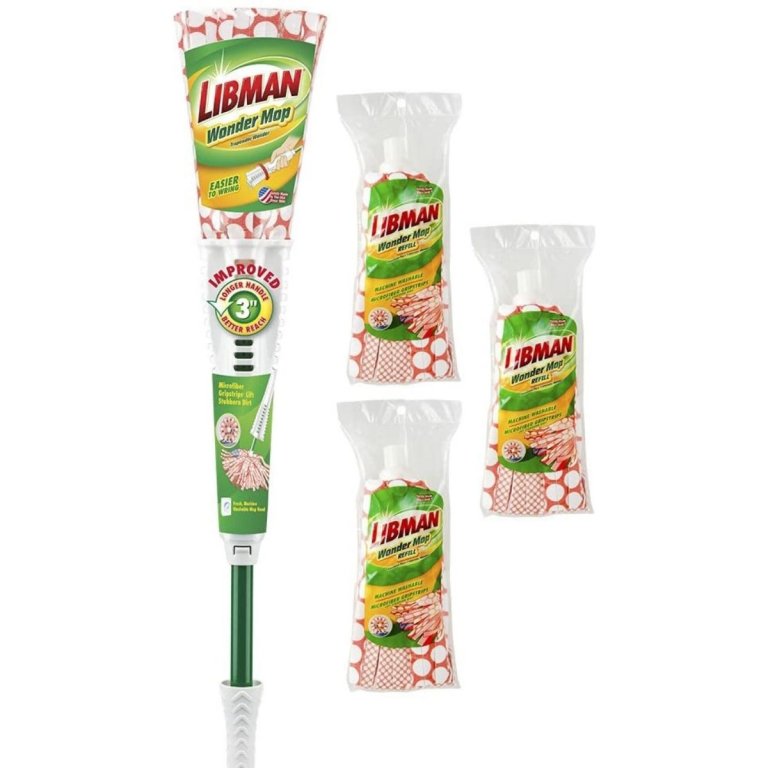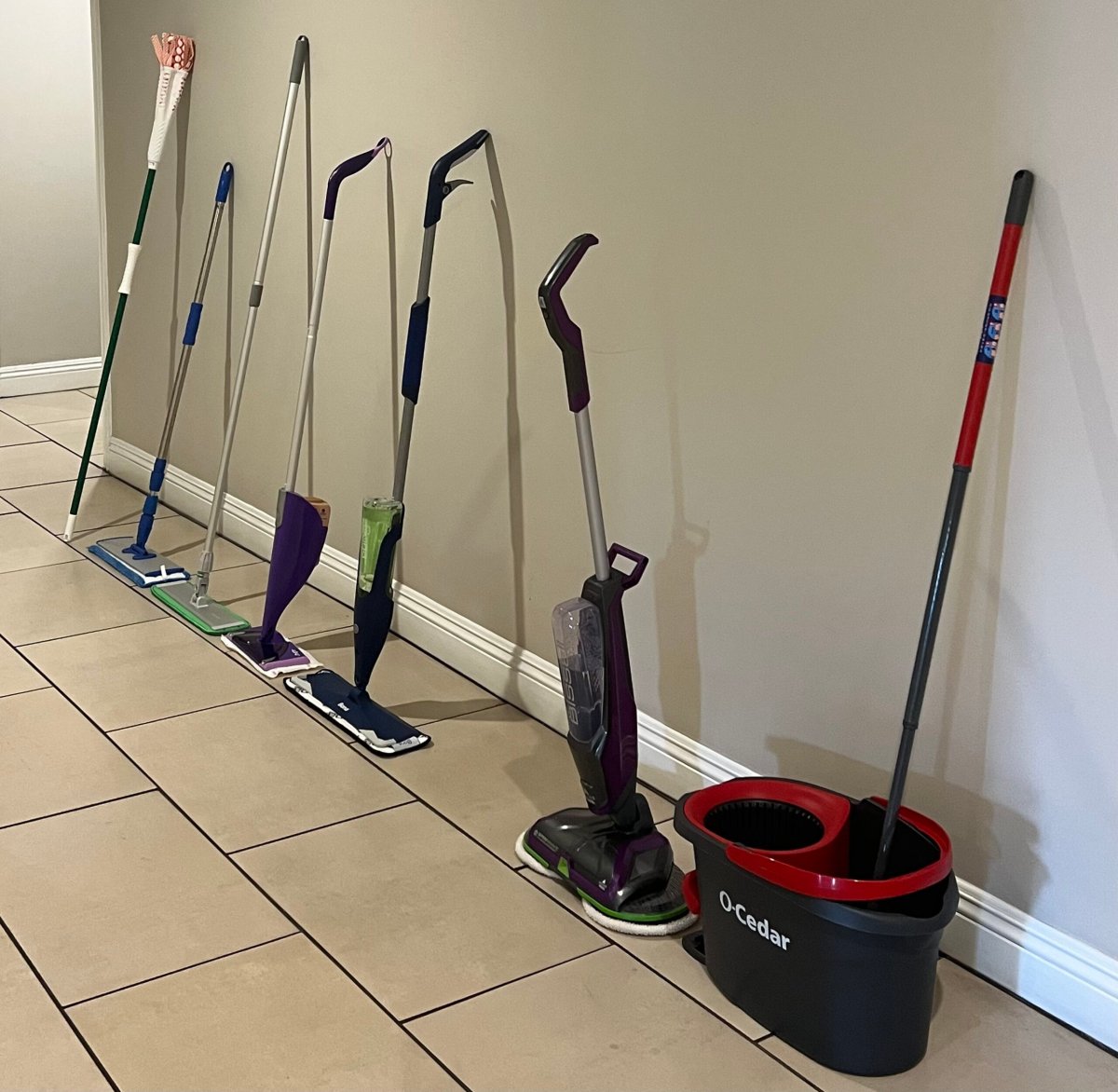
We may earn revenue from the products available on this page and participate in affiliate programs. Learn More ›
Mopping can be a tedious task, but specially designed mops for tile floors can make things easier. They get floors clean without damaging them and don’t just push dirty water around underfoot. Instead, they clear messes and stains from every crevice and are easy to wring out. A simple-to-use, ergonomically designed mop will get tiled kitchens, bathrooms, and utility rooms sparkling clean without hassle.
We rigorously tested some of the best mops on the market. Our top pick is the Bissell SpinWave Cordless Hard Floor Spin Mop; it cleans quickly, easily, and requires no elbow grease. Read on to learn about the features to look for when shopping for more of the best mops for tile floors and the type of mop that might be best for cleaning your household.
- BEST OVERALL: Bissell SpinWave Cordless Hard Floor Spin Mop
↓ Jump to Review - BEST BANG FOR THE BUCK: Swiffer WetJet Mop Starter Kit
↓ Jump to Review - BEST FLAT: Microfiber Wholesale Store 18-Inch Professional Mop
↓ Jump to Review - BEST SPRAY: Bona Premium Spray Mop for Hard-Surface Floors
↓ Jump to Review - BEST SPIN: O-Cedar EasyWring Spin Mop and Bucket System
↓ Jump to Review - BEST STEAM: Shark Genius Hard Floor Pocket Mop Cleaning System
↓ Jump to Review - MOST VERSATILE: Bissell Symphony All-in-One Vacuum and Sanitizing Mop
↓ Jump to Review - BEST MICROFIBER: Turbo Microfiber Mop Floor Cleaning System
↓ Jump to Review - ALSO CONSIDER: Libman Wonder Mop & Refills Kit
↓ Jump to Review

How We Tested the Best Mops for Tile Floors
We performed a variety of tests to determine the best mops for tile floors. We considered factors such as how well they cleaned dirt as well as stuck-on food and drinks, and how clean the floor looked after it dried. Everything was rated on a scale of 1 to 4 points.
In addition to cleaning, we tested the mops for maneuverability, wringing mechanism (if it was applicable), and how well the mop cleaned corners. Mops were also given points for how likely we were to use them again, as well as the overall value of the product for the price.
| Testing Stats | |
|---|---|
| Products tested | 9 |
| Time spent testing | 4 hours |
| Tests performed | 5 to 6 |
| Price range | $29 to $177 |
Our Top Picks
When choosing the best mop for tile floors, an important consideration is the type of tile in your home. Ceramic and porcelain tiles are very durable and can pretty well handle any mop. On the other hand, some natural stone tiles, such as slate or marble, are more prone to scratching. They should be cleaned by nonabrasive mops without rough scouring pads.
Each of the recommended floor mops on this list is gentle, easy to use, and provides a deep clean without the risk of damage. Keep tile floors in your home looking their best with these effective mops. All of these products were tested based on a variety of cleaning factors and mop features.
Best Overall
Bissell SpinWave Cordless Hard Floor Spin Mop
What We Like
- Great for cleaning all the way up to the edges of a room
- Practically cleans for you; no elbow grease necessary
- Battery-powered; no cord
What We Don’t Like
- Speed isn’t adjustable
- Feels a bit heavy to operate
Product Specs
- Mophead material: Microfiber
- Reusable mophead: Yes
- Adjustable handle: No
No elbow grease, no problem. The Bissell SpinWave is a heavy-duty mop with two rotating mop pads that easily power through dirt, scuffs, and stuck-on messes. We found this product to be the easiest to use because the mechanism does all the hard work for you. This electric mop is effective at cleaning tile, wood, linoleum, and other sealed hard floors.
Since it doesn’t use steam, the SpinWave is gentle enough for most sealed flooring. This mop is cordless, so it’s easy to maneuver, and each charge provides up to 20 minutes of cleaning time. Because it cleans so quickly, 20 minutes will more than suffice for even some larger spaces.
The SpinWave’s on-demand spray mechanism allows users to control the amount of cleaning solution distributed. Another point in this mop’s favor is that it comes with two soft-touch pads and two scrubby pads. The machine-washable mop pads are ideal for tile flooring—they’ll clean floors and restore the tile’s shine. What’s more, they’re cost-effective and eco-friendly.
What our tester says: “Cleaning with this mop didn’t feel like hard work. I felt the motor working, and the mop was very easy to push along. I found that it cleans much faster than a typical mop can.”—Amanda Lauren, Product Reviews tester & writer
Get the Bissell SpinWave mop for tile floors at Amazon, Wayfair, or Bissell.
Best Bang for the Buck
Swiffer WetJet Mop Starter Kit
What We Like
- Cleans floors well with little effort
- Pads are easy to put on and remove
- Doesn’t require a cord or charging
What We Don’t Like
- Tough stains can require a bit of elbow grease
- Replacement single-use pads can become quite pricey
Product Specs
- Mophead material: Synthetic
- Reusable mophead: No
- Adjustable handle: No
For budget-friendly cleaning of all your home’s hard floor surfaces, reach for the Swiffer WetJet spray mop. It’s useful for cleaning sealed tiles, finished wood floors, and other hard surfaces.
Swiffer’s handy mop pads trap dirt deep in the pad rather than pushing it around the floor. Each pad has an absorbent scrubbing strip to pick up tough grime. The mopping pad works in concert with the dual-nozzle sprayer, which provides a wide mist of cleaning solution so no spot is missed.
The disposable pads don’t pick up as well as microfiber pads do. So, when we were testing this mop, we found it required more elbow grease than microfiber mops. You may need to use a bit of extra solution to lift stuck-on messes, but eventually the Swiffer gets the job done.
This starter kit includes one WetJet mop, 10 mopping pads, and one bottle of cleaning solution. It has all the necessary parts included to get mopping, all for an affordable price. Better yet, it doesn’t take up a lot of space, so just stash it away in a closet for easy storage.
Get the Swiffer mop for tile floors at Amazon, Lowe’s, The Home Depot, or Target.
Best Flat
Microfiber Wholesale Store 18-Inch Professional Mop
What We Like
- Handle adjusts high to accommodate taller users
- Suitable for all surfaces
- Comes with extra microfiber cloths
- Pads are great for grabbing dust bunnies
What We Don’t Like
- Can be challenging to wring out and store
Product Specs
- Mophead material: Microfiber
- Reusable mophead: Yes
- Adjustable handle: Yes
Microfiber Wholesale’s mop set includes three microfiber mop pads: a dust pad to pick up dust and hair, and two wet mop pads to tackle dried-on messes. The extra-wide 18-inch mophead makes quick work of large rooms. The gentle mop pads are safe to use on any hard flooring surface; they also can work on walls and the ceiling for a full-home cleaning. It’s light to move around, which is a bonus for people with injuries or limited mobility.
Each mop pad is machine washable and long lasting. The wet mop pads have foam cores and two types of microfiber. Microfiber loops around the pads’ edges pick up larger pieces of debris, like hair and crumbs. The soft microfiber center grabs smaller pieces of dust and dirt, leaving tile floors squeaky-clean.
When we tested this mop, we realized it could be used for more than just floors. It can easily help clean walls and ceilings. The adjustable handle extends from 42 inches to 70 inches with a twist of the handle lock to reach up high. One of this mop’s best features is its mophead, which has a 360-degree swivel with a lock. The swivel lock feature keeps the head in place to prevent side-to-side swiveling.
The only feature we felt this mop could have used was a lever to fold it in half for wringing out or for easier storage.
Best Spray
Bona Premium Spray Mop for Hard-Surface Floors
What We Like
- Reusable pad is easy to remove and clean
- Trigger on handle
- Includes a 34-ounce bottle of cleaning solution
What We Don’t Like
- Pads can’t be washed with fabrics that produce lint
Product Specs
- Mophead material: Microfiber
- Reusable mophead: Yes
- Adjustable handle: No
Some mop sprayers emit too much liquid and can make floors too wet, which creates a slipping hazard and makes mopping a tile floor difficult, but not so with this spray mop. One nice thing about Bona’s mop is that it has a fine-mist sprayer, which coats floors in a layer of cleaning solution without making them too wet.
The mop’s refillable 34-ounce floor cleaner bottle comes prefilled; its large size contains ample spray for large rooms so there’s no need to stop and refill the fluid in the middle of a cleaning. It also won’t need to be replaced quickly, which is very helpful.
In testing, both the mop and solution helped us clean the room quickly and efficiently. The sprayer is easy to control with a trigger in the curved upper part of the mop’s handle. A second foam grip halfway down the pole allows for extra control, particularly during harder scrubbing.
Those who are looking for reusable mopheads and have lots of obstacles to navigate while cleaning will want to consider the Bona mop. The mophead is made of a washable microfiber, which allows for gentle cleaning, and it has rubber corners to protect furniture and baseboards while scrubbing. It’s a great mop for most everyday uses and in homes.
What our tester says: “Overall, I was impressed with the spray trigger, which didn’t require batteries to work, so it’s an economical and eco-friendly choice. It was also one of the most comfortable flat mops I’ve ever used.”—Amanda Lauren, Product Reviews tester & writer
Get the Bona mop for tile floors at Amazon, The Home Depot, or Target.
Best Spin
O-Cedar EasyWring Spin Mop and Bucket System
What We Like
- Lever makes it easy to wring out
- Thick mophead and sides easily cleans corners and moldings
- Mop is extremely easy to maneuver
What We Don’t Like
- Can end up wasting water over time
Product Specs
- Mophead material: Microfiber
- Reusable mophead: Yes
- Adjustable handle: Yes
O-Cedar’s EasyWring spin mop and bucket set comes with both a microfiber mop and a bucket with a hands-free wringer. The EasyWring has a range of convenient features and is made to reach all corners of a room.
The pivoting mophead is triangular, which allows it to get into tight corners, under furniture, and along baseboards. For tough-to-reach spaces both high and low, take advantage of the telescoping handle, which can extend to 48 inches. The mop can be used wet or dry—its fluffy microfiber strands pick up dirt, hair, dust, and grime from hard floor surfaces.
The EasyWring bucket’s foot pedal provides hands-free wringing without having to bend over. Splash guards surrounding the wringer keep water inside the bucket—not all over your floor.
Our tests found that this was the best mop for getting into small, tight corners. It’s also great for cleaning moldings quickly and efficiently. While it doesn’t have tons of bells and whistles, this mop is just right for anyone who worries about having floors that are too wet. It’s also very light, and therefore a smart choice for anyone with mobility issues.
Get the O-Cedar mop for tile floors at Amazon, The Home Depot, Walmart, or Target.
Best Steam
Shark Genius Hard Floor Pocket Mop Cleaning System
What We Like
- Double-sided pads
- Touch-free release; no need to touch dirty pads
- Flask included to help users fill the tank without spilling
- Round ergonomic handle allows for smooth and comfortable swiveling
What We Don’t Like
- Tank is small and not removable
- Relatively expensive compared to similar options
Product Specs
- Mophead material: Synthetic
- Reusable mophead: Yes
- Adjustable handle: No
The Shark Genius’s mophead has channels that distribute steam from edge to edge throughout the mophead. The steam creates an ultrawide cleaning zone to tackle messes on tile floors. For stuck-on stains, the Shark’s steam blaster feature sends a targeted stream of steam to loosen dirt from corners and grout lines.
One of the Genius’s unique features is that instead of a single-sided cleaning pad, the mophead has a double-sided cleaning pocket—simply flip the head over when one side of the pad is soiled and continue cleaning. Each absorbent side has cleaning grips that lift and trap dirt. After cleaning, the soiled mop pad can be released with the press of a button, right into the washing machine or laundry hamper if you like.
This is also a great mop for apartments because it can clean a variety of surfaces. Because it doesn’t take up too much space, it can easily fit in a closet or hang on a wall for storage.
This mop was incredibly satisfying to test. It makes a sound as the steam heats up and releases. We suddenly had a feeling our floors were about to get really clean.
What our tester says: “Looking at the bottom of the pad after cleaning, I was shocked to see how much dirt came up.”—Amanda Lauren, Product Reviews tester & writer
Get the Shark mop for tile floors at Amazon or The Home Depot.
Most Versatile
Bissell Symphony All-in-One Vacuum and Sanitizing Mop
What We Like
- Works well on heavy stains
- Great for homes with pets
- Reusable and disposable pads
- Comes with an extra head
What We Don’t Like
- Water container is hard to fill and requires a spout
- Dirt cup can be difficult to open and close
Product Specs
- Mophead material: Microfiber and synthetic
- Reusable mophead: Yes (plus disposable)
- Adjustable handle: No
For those who have pets and usually have to vacuum their floors immediately before washing them, this two-in-one vacuum and mop system can be a big time saver. The Bissell Symphony cleaning system vacuums, sanitizes, and steam-cleans floors, all in one sweep. Its vacuum draws up dust, dirt, and pet hair—and its dirt canister has hands-free emptying with the push of a button.
Right behind the vacuum are the steam-cleaning feature and mopping pad, which tackles dirt and stuck-on messes. This handy cleaning tool is safe to use on all sealed hard floors in the home. Just keep in mind that you’ll want a container with a spout to fill up the water cup.
The Symphony kit includes two washable mop pads: one soft option for light cleaning and one scrubby pad for bigger messes. Because the Symphony mop was originally designed for cleaning up after pets, it can also be used with Bissell’s disposable mop pads (sold separately).
Disposable pads are a terrific option when pet messes are so considerable that it’s best to throw the pads away. However, our tests showed the disposable pads were better for lighter messes such as pet hair and urine, while reusable pads were best for larger and stuck-on messes.
Get the Bissell Symphony mop for tile floors at Amazon, Lowe’s, Walmart, or Bissell.
Best Microfiber
Turbo Microfiber Mop Floor Cleaning System
What We Like
- Very large pads can tackle big areas quickly
- Easy to assemble
- Washable pads stick on and come off easily
- Simple and easy to maneuver
What We Don’t Like
- Long nonadjustable handle is not easy to store in small spaces
- Scrubber pad doesn’t last many uses before needing replacement
Product Specs
- Mophead material: Microfiber
- Reusable mophead: Yes
- Adjustable handle: Yes
If you’re looking for an affordable floor cleaning mop that gets the job done without lots of extra bells and whistles, the Turbo Microfiber mop system will not disappoint. Weighing in at just 1.2 pounds, this mop is lightweight and easy to control. The handle extends from 35 to 60 inches, so this is an optimal choice for households with people of different heights. It can also clean and dust walls as well as ceilings.
Four pads come with each mop. There are two microfiber pads perfect for everyday jobs as well as two scrubbing pads that are made from a steel wool type of material that grips and removes stuck-on food and grease.
When we tested this scrubbing pad, we were a bit nervous about it possibly scratching the floor. While it lifted stuck-on dirt from tile flooring, we wouldn’t use this on marble or anything that isn’t sealed.
Get the Turbo Microfiber mop for tile floors at Amazon.
Also Consider
Libman Wonder Mop & Refills Kit
What We Like
- Comes with 3 mopheads
- Ideal for getting under doors and appliances
- Thick, floppy mophead is great for cleaning moldings
What We Don’t Like
- Mopheads can only be washed 50 times
- A little hard to wring out; can end up with wet floors
Product Specs
- Mophead material: Microfiber
- Reusable mophead: Yes
- Adjustable handle: No
Libman’s Wonder Mop is a back-to-basics, simple strip mop. Its microfiber mophead can be used on all hard floors, including tile, wood, stone, and vinyl; the head also has “Gripstrips” that scrub stubborn dirt. When the mophead starts to look a little grubby, toss it in the washing machine for a deep clean. Because this package comes with three mopheads, there’s no need to wait until laundry day to use it.
A mop with a durable handle is key for deep scrubbing, and the Wonder Mop’s steel handle can withstand deep-cleaning pressure. The handle also has a wringer cup, which pushes down over the mophead to squeeze water out. However, when we tested it, the cup was a bit hard to maneuver. This set includes three replacement mopheads that only last about 50 washings.
We were impressed at how well this mop cleaned corners, under appliances, and along moldings. It’s also perfect for getting rid of dust bunnies. This mop lifted dirt far better than we anticipated, living up to its name.
Get the Libman mop for tile floors at Amazon.
Jump to Our Top Picks
What to Consider When Choosing a Mop for Tile Floors
A mop is an essential tool in one’s housekeeping arsenal, but with so many options to choose from, it’s sometimes difficult to determine which model is best for your home. When choosing the best mop for tile floors, it’s important to consider such factors as the mop’s material, wringing mechanism, and maneuverability. Additional features such as adjustable handles, spray mechanisms, and electronic mopheads can make cleaning even easier.
Type
The most common mop types for household cleaning include string, strip, flat, spray, and steam mops, and each type has its advantages and disadvantages.
- String mops are the traditional go-to mops for both residential and commercial cleaning. The mophead is made from strands or loops of string, usually cotton. These mops are very absorbent and effective at cleaning large surfaces. They’re also the best for getting into narrow corners and tight spaces. However, they can be tough to wring out or fully dry because the strings absorb a lot of water and can become rather stinky as a result.
- Strip mops are very similar to string mops, but the mophead consists of strips of fabric rather than cotton strings. The fabric strips are usually made of synthetic materials. These mops tend to absorb less water and dry more quickly, so they’re less likely to stay damp and develop an odor.
- Flat mops have a flat head with a cleaning pad. The mopping pad can be disposable, reusable, or machine washable. A lightweight and easy-to-use option, flat mops are a popular pick for daily home cleaning.
- Spray mops eliminate the need to tote around a mop bucket as you clean. Spray mops have a bottle of cleaning solution mounted on the mop handle. At the squeeze of a trigger, the solution sprays on the floor for easy cleaning.
- Steam mops are electrical mops that have a refillable water tank. When the mop is turned on, its water heats up and turns to steam, which spreads through the mophead and onto the floor. The hot steam is effective at disinfecting and cleaning tough messes. A steam mop for tile floors is an excellent pick for sealed ceramic and porcelain tiles, which are the most popular type of tiling in residential homes.
Mophead
The material from which the mophead is made affects how absorbent, abrasive, or gentle a mop is. Common mophead materials include cotton, synthetics, microfiber, and sponges.
- Cotton mopheads are affordable and very absorbent. Because they’re so absorbent, they’re great for cleaning up liquid messes. The downside to their absorbency is that they can be slow to dry, which makes them prone to mildew or damp odors.
- Synthetic fibers are more durable than cotton fibers. Synthetic fibers usually dry quickly, which makes them less prone to damp odors and mildew.
- Microfiber is long lasting and easy to clean. Microfiber mops are absorbent and soft and run very little risk of damaging flooring.
- Sponge mopheads are textured and are ideal for scrubbing out spots. Some sponge mopheads may push dirty water into tile grout, causing it to look dingy. They’re still a popular pick, however, because they have excellent scrubbing power.
Wringing Mechanism
To avoid damaging flooring, it is best to clean with a mophead that is damp but not too wet, which is where a mop’s wringing mechanism comes into play. Mop wringers are typically located on either the mop’s handle or in the mop bucket.
Most wringers on the mop come as either lever or twist mechanisms on the mop’s handle. Activating the wringer applies pressure to the mophead to squeeze out excess water.
Lever wringers are common on sponge mops. When the lever is pulled, the mechanism will fold or roll the sponge to squeeze out water. Some string and strip mops are marketed as self-wringing, which means they’re equipped with a twist mechanism that winds the mop fibers and removes water.
Bucket wringers are built into a mop’s bucket. Some wringers are fairly simple—they squeeze water from a mop using manual pressure. Buckets that come with spin mops allow for hands-free wringing—rather than touching a dirty, wet mop, one depresses a foot or hand pedal to expel water from the mophead. Spin mops are convenient to use and usually dry out better than most other bucket wringers.
Handle
A mop’s handle has a lot to do with how comfortable the mop is to use overall. Mop handles are commonly made from plastic, wood, or metal. Handles made of wood or metal are less prone to bending and breaking. Plastic is usually used for a handle’s extra features and accessories—its push buttons, levers, spray nozzles, and comfort grips.
No matter the mop handle’s material, it’s a good idea to look for one that features ergonomic or nonslip grips for added comfort. Nonslip grips help the user keep control of the mop, even with hands that are wet from cleaning and wringing. The more comfortable and ergonomic the handle’s grip is, the easier it will be to use the mop for an extended period of time without tiring or cramping. An adjustable-height handle also contributes to comfort.
Adjustability
A height-adjustable handle, which extends or contracts to suit users of all heights, is a useful feature to seek out when shopping for the best mop for tile floors. An adjustable handle also eliminates the need for stooping or wielding a too-long handle.
Those whose mopping duties range from quick cleanups to intense scrubbing will want to give mops with adjustable handles particular consideration. A shorter handle allows the user to apply more pressure while scrubbing hard, stuck-on messes. For lighter cleaning, a longer handle height allows mop users to sweep the floor with broad strokes and quickly cover more ground.
Maneuverability
The most difficult parts about getting tile floors squeaky-clean is getting under and around furniture, into tight corners, and up against baseboards. Flat mops, particularly those with rotating heads, are especially useful for these tasks because they are lightweight, have slim profiles, and can maneuver around and under furniture and other household obstacles.
Most string, strip, and spin mops are also fairly maneuverable. Most have round heads with cleaning fibers that are pliable and can reach into corners. Because they don’t have as low a profile as flat mops do, however, it may take more effort to clean under furniture and cabinets—and they may not get into every nook and cranny.
Sponge mops are stiffer and thicker than the other types discussed and may have trouble fitting into tight spaces. Electric and steam mops are the heaviest, bulkiest mops for tile floors and are generally the most unwieldy, particularly when carrying them up and down stairs. These mops are super effective, however, for cleaning areas that they can reach.
Additional Features
Many of the best mops for tile floors have multiuse functions and additional features. Some steam mops can tackle other deep-cleaning tasks, such as grout cleaning. Combined vacuum and mopping devices offer a two-in-one solution for cleaning tile flooring.
Some flat and microfiber mops include a dust mop pad that tackles dusting and mopping all at once. These pads can even be used for dusting walls and ceilings, and the mop’s long handle has a farther reach than that of a regular duster.
While researching the best mop for tile floors for your needs, it’s important to think about how often you’ll need to replace the mopheads and how much they cost. Mops have either disposable, reusable, or washable mopheads. Although disposable mopheads feel most hygienic, replacements are not great for the environment and can be pricey over the long term. Reusable and washable mopheads need frequent cleaning to prevent bad smells and mildew, but the extra maintenance is worthwhile—they are cost-effective and eco-friendly options.
FAQs
A mop is a simple cleaning tool, but there is a technique for keeping floors sparkling clean. For the best clean, always sweep or vacuum tile floors before mopping. Here are some questions and cleaning tips to consider when using your new mop.
Tile floors should be vacuumed or swept and then mopped about once a week. Combine your floor or tile cleaner of choice with warm water. If using a mop bucket, make sure to squeeze the excess water out of the mophead. Tile floors should be cleaned with a damp mop. Swipe the mop over the floor in gentle strokes, making sure to follow a pattern so you don’t miss any spots.
It is recommended to mop tile floors once a week and spot clean as needed in between.
Since most mops have a replaceable head, it is rarely necessary to replace the entire mop unless it has become damaged. Mopheads should be replaced once they are looking worse for wear, usually every 2 or 3 months. Permanent stains or a lingering odor typically indicate that it’s time for a new mophead.
Steam mops are a very effective way to clean tile floors as they not only clean but also sanitize tile and grout. However, they can cause damage on other surfaces and should not be used on vinyl, laminate, or unsealed hardwood.
Experts recommend using hot water if your cleaner is made with more natural ingredients (vinegar or baking soda). This is because the heat makes the ingredients more effective cleaners. However, the opposite is true with bleach; use cold water when diluting.
Your tile floor may still be dirty after mopping due to a variety of reasons. Depending on your choice of what to clean tile floors with, some cleaners can leave a residue behind that attracts dirt. Using too much of a cleaner can also create a buildup on floors that make them look dirty. Always use a clean mophead at the outset of your cleaning.
Why Trust Bob Vila
Bob Vila has been America’s Handyman since 1979. As the host of beloved and groundbreaking TV series, including This Old House and Bob Vila’s Home Again, he popularized and became synonymous with “do it yourself” home improvement.
Over the course of his decades-long career, Bob Vila has helped millions of people build, renovate, repair, and live better each day—a tradition that continues today with expert yet accessible home advice. The Bob Vila team distills need-to-know information into project tutorials, maintenance guides, tool 101s, and more. These home and garden experts then thoroughly research, vet, and recommend products that support homeowners, renters, DIYers, and professionals in their to-do lists.

